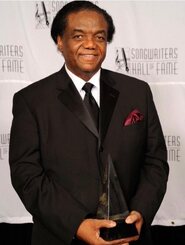 As part of the incomparable songwriting team Holland–Dozier–Holland, the Detroit native co-wrote some of Motown’s most enduring songs. BY:EMILY ZEMLER & JON BLISTEIN Lamont Dozier, the Motown songwriter and producer who helped craft hits for artists such as the Supremes, the Four Tops, and the Isley Brothers, has died. He was 81. The news was confirmed by his son, Lamont Dozier Jr., who wrote on Instagram, “Rest in Heavenly Peace, Dad!” A cause of death has not yet been announced. Dozier was born in Detroit on June 16, 1941 and launched his career in music as a singer, performing with various local doo-wop groups like the Romeos and the Voicemasters. In 1962, he signed to the Berry Gordy’s fledgling Motown records as an artist, producer, and songwriter, and quickly found himself working with brothers Brian and Eddie Holland. The trio — which came to be known as Holland-Dozier-Holland, or just H-D-H — turned out a few deep cuts during their year together, but generation-defining success came soon enough. In 1963, Holland-Dozier-Holland scored their first Top 10 hits with Martha and the Vandellas’ “Heat Wave” and “Quicksand,” as well as the Miracles’ “Mickey’s Monkey.” While Eddie Holland primarily crafted the lyrics and vocal productions for the songs they wrote, Dozier and Brian Holland served as the team’s main producers and arrangers, working closely with Motown’s house band, the Funk Brothers, to fine-tune the label’s signature blend of R&B and pop (with some grand orchestral flourishes thrown in for good measure). In 1964, the songwriting and the sound came together perfectly with the vocal talent and star power when Holland-Dozier Holland partnered with the Supremes. That year H-D-H crafted three iconic Number Ones for the girl group, “Where Did Our Love Go,” “Baby Love,” and “Come See About Me.” In a 2003 interview with Rolling Stone, Dozier said it was after “Where Did Our Love Go” hit Number One that he knew H-D-H had a special kind of chemistry: “Brian and I used to have lunch at that little walk-up, and once that wheel started rolling with ‘Where Did Our Love Go,’ I said, ‘Man, we’ve stumbled up into something — are you feeling this?’ He said, ‘Yeah, I’m feeling it too.’ I said, ‘I don’t know what this is, but I don’t think this thing is going to stop.’ … It was like being at the carnival and hitting that bell, Bam! Number One! Bam! Number One! Bam! Number One! When we weren’t doing that with the Supremes, we were over here with the Four Tops. Bam! It was surreal.” H-D-H scored seven more Number Ones with the Supremes, bringing their total with the group to 10 in the brief period between 1964 and 1967. On top of that, the trio was also penning and producing timeless hits for other Motown favorites, like Marvin Gaye’s “How Sweet It Is (To Be Loved By You)” and the Four Tops’ “I Can’t Help Myself (Sugar Pie Honey Bunch)” and “Reach Out I’ll Be There.” Recalling the making of the latter track in The Wall Street Journal in 2013, Dozier remembered how they encouraged Four Tops vocalist Levi Stubbs to tap into his inner-Bob Dylan while recording the lyrics. “Back in ’66, we were listening a lot to Bob Dylan. He was the poet then, and we were inspired by his talk-singing style on ‘Like a Rolling Stone.’ Dylan was something else — a guy we looked up to. We loved the complexity of his lyrics and how he spoke the lines and sang them in places. We wanted Levi to shout-sing ‘Reach Outs’’s lyrics — as a shout-out to Dylan.” In 1967, however, Holland-Dozier-Holland left Motown over a contract dispute with label founder Berry Gordy. Subsequent litigation wasn’t settled until the late Seventies, but during that time, the trio kept launched their own labels, Invictus and Hot Wax, and kept making music. In 1970, they scored hits with the Chairmen of the Board’s “Give Me Just a Little More Time” and Freda Payne’s “Band of Gold.” And Dozier also started making music himself again, releasing a handful of high-charting R&B tunes including 1972’s “Why Can’t We Be Lovers” (which was credited to Dozier and Brian Holland), and 1973’s “Trying to Hold on to My Woman.” Dozier return to the top of the charts one more time in the late Eighties when he partnered with Phil Collins to co-write and produce, “Two Hearts,” which appeared on the soundtrack for the film Buster. Along with hitting Number One, the song was nominated for Best Original Song at the Oscars, shared the Golden Globe in the same category with Carly Simon’s “Let the River Run” (from Working Girl), and notched Dozier his first Grammy nomination and win (for Best Song Written Specifically For A Motion Picture Or Television). In 1988, Holland-Dozier-Holland was inducted into the Songwriters Hall of Fame, while two years later they were inducted into the Rock and Roll Hall of Fame. In a 2019 interview with the Detroit Free Press, as Dozier prepared to publish his memoir, aptly titled, How Sweet It Is, the songwriter reflected on his work and the remarkable legacy of the music he helped create. “Everything I write, I give credit to God, the master muse,” he said. “I thank him for letting me put my name on his music. That’s how I started [regarding] it. I don’t read music, and I can’t write it either. I did it all by ear and feeling when I sat down at the piano… But I still hear that stuff over and over. It still hasn’t let up. They still play that music, man. It’s amazing. I thought some of it wouldn’t last a day. But it’s been here for 60 years, and that’s a great feeling — all over the world.
0 Comments
Your comment will be posted after it is approved.
Leave a Reply. |
Archives
March 2024
Categories |
 RSS Feed
RSS Feed